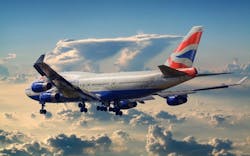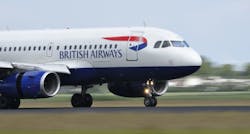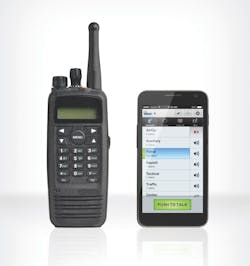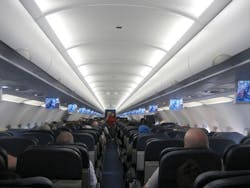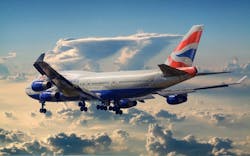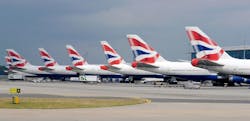British Airways deploys Twisted Pair’s WAVE to extend ground-to-air radio communications to desktop PCs
British Airways (BA), headquartered in London with its main hub at Heathrow Airport, is one of the world’s largest international airlines. It is the airport’s major operator, controlling approximately 50 percent of flights to and from the airport, and is the largest airline in the U.K. based on fleet size, international flights and international destinations. The airline operates more than 300,000 flights per year and in 2011/12 carried more than 34 million passengers to nearly 150 destinations.
Like many airlines around the world, BA operates on tight margins. The International Air Transport Association (IATA)—the aviation industry’s lobby group—predicted a member profitability margin of less than 1 percent as a result of high oil prices and a poor global economic climate. Air transport operations were also hard-hit by events on 9/11. The industry as a whole has had to reshape to cope with the after effects. Investment in new fleets and technology has been the key to recovery, along with careful capacity management, efficient process adoption and consolidation. Inefficient airline operations can mean that airlines incur fines. It is therefore vital for British Airways to have efficient and streamlined communications to support swift aircraft turnaround operations.
Ground-to-air communications are a critical element of airline operations, providing the ability to communicate between the airline’s flight deck and the operational control center for a range of up to 200 nautical miles. For outbound and inbound flights, information relating to the aircraft and its passengers can be relayed, ensuring that the necessary preparations for passenger assistance or aircraft maintenance can be implemented prior to the aircraft landing. Ground-to-air communications are used by British Airways to facilitate efficient aircraft turnaround, helping to avoid the financial penalties associated with schedule delays.
The ground-to-air radio system in use by British Airways consists of multiple radio base stations connected to a series of remote terminals distributed throughout Heathrow airport. In its original form, the British Airways ground-to-air radio system was connected to a legacy switch in the operations facility at its former main office, the Compass Centre, via a series of leased lines. Further leased lines were in use between the audio switch and the desk remote control units, where British Airways users would receive, process and respond to the information. The distributed nature of British Airways’ leased line infrastructure was a result of having airline operations across the entire Heathrow campus.
The Challenge
There were several driving factors for British Airways to commence this project. Firstly, BA needed to relocate operations from its facility in the Compass Centre to its Waterside headquarters and the new Terminal 5. Secondly, the airline needed to reduce the total cost of ownership of voice, video and data services in use. Finally, British Airways wanted a way to manage communication services with ease.
The audio switch in use at the Compass Centre presented a number of challenges to BA as part of the move into Waterside and Terminal 5. It was based on proprietary protocol, hardware-based, hard-wired and nearing full capacity. British Airways therefore needed to decide to either retain and move its legacy audio switch system or replace it.
With ground-to-air communications being critical to airline operations, moving the audio switch in a ‘lift-and-shift’ manner was not feasible. The age and relative fragility of the audio switch was a concern, calling into question the longevity of the aged equipment. In addition, a move of the audio switch would mean a total loss of communications while the system was physically moved from the Compass Centre into the new locations.
To ensure continuity of service during the move, the audio switch and the infrastructure on which it operates would need to be replicated and fully functional in the new locations before the existing implementation in the Compass Centre could be switched off. A full replication of the audio switch and leased line connectivity would be both time consuming and expensive for British Airways.
A further consideration was the user capacity on the audio switch. Operating at nearly full capacity, there was little scope to economically provide for additional user desk positions. The reliance on fixed position hardware meant that the flexibility for ongoing moves and changes was limited. In addition, the audio switch utilized bespoke signaling, which meant that the additional application integration would be complex and costly for British Airways.
In support of its technology strategy to embrace IP, British Airways had already deployed a CCCM IP telephony solution operating on a converged IP network. With IP convergence enabling voice and data packets to be transported on a single network infrastructure, British Airways was now in a position to also transfer its ground-to-air communications onto its IP network.
“Our network convergence project was primarily focused on streamlining the management and provisioning of telephony services throughout the company,” said Lee Weatherley, voice and video solutions manager at British Airways. “We are now exploring ways to exploit the new network to support other forms of communication—for example, we also operate paging, TV, video conferencing and CCTV over our IP network.”
The Solution
To replace its audio switch and leased line connectivity, British Airways selected an on-premise, fully managed and maintained solution from Twisted Pair’s international partner Affini. The solution features Twisted Pair’s WAVE, a Radio over IP (RoIP) software platform, operating on British Airways’ existing converged IP network. Comprised of a number of elements, the WAVE solution deployed included clients on standard desktop PCs, and bespoke server infrastructure.
Twisted Pair’s WAVE was recommended for and deployed to British Airways because it provides secure, real-time communications from any IP enabled position on the network and from a number of industry standard smartphone devices. This capability means that all British Airways end users, whether mobile or in the office, can effectively communicate and collaborate through voice, text and data. Using WAVE, British Airways now has the opportunity to operate a mixed estate of devices without impairing functionality.
Deployed to more than 75 operational positions serving in excess of 1,000 users, the WAVE Desktop Communicator application allows British Airways’ operators to communicate to smartphones, radios and carrier push-to-talk (PTT) networks from any WAVE-enabled PC, across a secure network infrastructure. This capability not only removes the need to deploy radio handsets to desktop workers who don’t need them, but also allows users to participate in communications between multiple radio channels. In addition, the Desktop Communicator provides activity displays, audio recording and instant replay to give users a complete communications history.
As a communications platform, WAVE is unrivalled. One of the key benefits to British Airways is the capability to cost effectively globalize radio communications. Using WAVE, British Airways now has the ability to replicate its U.K. control center anywhere in the world. Furthermore, British Airways’ ground-to-air communications now benefit from the inherent resilience of its fully redundant IP network infrastructure.
Delivered as a fully managed service, the chosen solution is “light-touch” for British Airways—minimizing risk and uncertainty while optimizing efficiency and performance. WAVE is a future-proof IP communications solution, using Radio over IP technology to extend ground-to-air communications to a range of smartphones and tablets. Its flexible architecture supports additions, moves and changes for future business expansion.
“WAVE is a tremendously powerful unified communications platform with a suite of applications that makes it possible for teams of people, whether mobile or in their offices, to effectively communicate and collaborate,” Weatherley said.
The Results
The implementation of WAVE has delivered a number of benefits to British Airways. WAVE operates on a single IP network infrastructure, making it accessible from any location and from a range of devices. This provides British Airways with a flexible and scalable ground-to-air communications capability that can be extended to any location in the world. By supporting communications to a wider community of interest, WAVE also helps optimize aircraft operations and leverage investments in existing assets around the airport.
WAVE was also specifically deployed to ensure a seamless transition from legacy infrastructure. Its ease of deployment reduces the risk of downtime often associated with major infrastructure upgrades, and offered minimal disruption to British Airways users. This elimination of downtime and lack of significant hardware upgrades allowed the airline to save on costs.
With radio communications distributed over an IP network to application-enabled wired and wireless devices, British Airways operations personnel have the flexibility to adapt to an ever-changing airport environment. The solution can be scaled to allow future expansion with ease, giving the airline the option to explore new or additional applications to support future interoperability.
“By putting our ground-to-air communications directly on our IP network, we could dispense with expensive remote terminals and leased lines, gaining the flexibility to adapt to every changing airport environment using any readily available network ports,” Weatherley said.
“We’re now looking at extending its capabilities further to include smartphones and tablets, running on carrier data networks, ensuring seamless communications in any location. In addition, we’re looking at the potential to integrate WAVE into a new enterprise collaboration platform and expand use of WAVE into the worldwide flight operations control center and LHR airport control center.”
For more information, visit www.twistpair.com or call (206) 442-2101.
